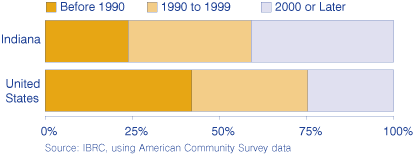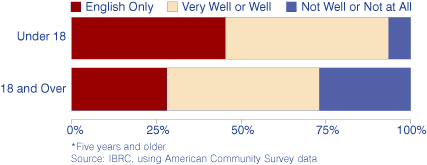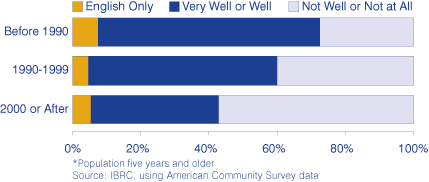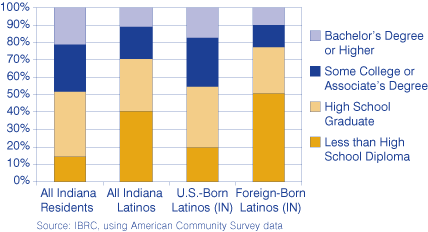Indiana's Changing Latino Population
The United States has long been a destination for people in search of economic opportunity. Certainly, education is a key determinant of economic prosperity and social mobility, and English language proficiency is generally a critical step toward educational attainment. These issues are especially prominent today as language proficiency has been central to the debate on immigration, particularly as it pertains to those coming from Latin America. So, how does Indiana's Latino population fare in terms of English language ability and educational attainment? More importantly, how does the passage of time and generations impact these indicators?
Overview of Indiana's Latino Population
Like much of the country, Indiana's Latino population is growing. According to the U.S. Census Bureau, Indiana's 277,558 Latino residents in 2005 represented the state's second largest minority group and accounted for 4.5 percent of the state's total population. Furthermore, census population estimates indicate that the Hoosier Latino population grew by 31 percent between 2000 and 2005 alone. That said, Indiana accounts for only 0.7 percent of the total U.S. Latino population.
While some of this growth is the product of natural increase (more births than deaths) most can be attributed to migration. For instance, 41 percent of Indiana's Latino population is foreign-born, which is comparable to the national rate of 40 percent. As Figure 1 indicates, however, the share of recent arrivals among Indiana's Latino population is considerably higher than the nation as a whole. Remarkably, 41 percent of the state's Latino immigrants entered the country between 2000 and 2005—compared to just 25 percent nationally. This trend can be attributed to the fact that states like California, Texas and Florida have much more established Latino populations.
Figure 1: Foreign-Born Latino Population by Year of Entry, 2005

Language
Table 1 highlights several perspectives on the Indiana Latino population's English language skills. For instance, 33 percent of Hoosier Latinos speak only English while an additional 46 percent report speaking English either “well” or “very well.” In contrast, of this state's foreign-born Latino population, nearly 43 percent do not have a solid grasp of English. Also, regardless of the native country, Spanish remains important to many, as shown by the language spoken at home statistics.
Table 1: English Language Ability and Language Spoken at Home for Indiana's Latino Population Five Years and Older, 2005
| Ability to Speak English | Entire Latino Population |
Latino Population Born in the United States |
Foreign-Born Latino Population |
| English only | 33.0% | 54.9% | 5.9% |
| Very well | 31.1% | 35.7% | 25.2% |
| Well | 15.0% | 6.1% | 26.2% |
| Not well | 13.3% | 2.9% | 26.4% |
| Not at all | 7.5% | 0.4% | 16.3% |
| Language Spoken at Home | |||
| English | 33.2% | 54.9% | 5.9% |
| Spanish | 66.5% | 44.7% | 93.7% |
The most important trend that these figures demonstrate, however, is what occurs when immigrants raise families in this country. In Indiana, the percentage of residents who either speak English only or speak the language “very well” jumps from 31 percent for foreign-born Latinos to 91 percent of those born in the United States. Furthermore, over half of the Latinos born in the United States speak English in the home.
The integrating effects of generational advancement are further shown when looking at English language ability by age. As Figure 2 shows, 94 percent of Indiana Latinos between the ages of 5 and 17 (nearly one-quarter of the total population) speak English at least “well” compared to 73 percent for the population 18 and over.
Figure 2: Ability to Speak English by Age for Indiana's Latino Population,* 2005

Another important factor in gaining English proficiency, not surprisingly, is the amount of time spent in this country. Figure 3 highlights the English language ability of Indiana's entire foreign-born Latino population based on the year of entry into the United States. Among the most recent Latino immigrants to enter this country and live in Indiana, 57 percent either speak English “not well” or “not at all.” This picture is quite different for the state's foreign-born population that entered the country prior to 2000; of those entering the country in the 1990s, 60 percent speak English at least “well.” That number jumps to 72 percent for those who entered the United States before 1990.
Figure 3: Speaking English—Differences by Year of Entry Significant for Foreign-Born Latinos* in Indiana, 2005

Education
Forty percent of Indiana's Latino population age 25 or above has less than a high school education compared to just 15 percent for the state's entire population. As with language, however, these figures are greatly influenced by the recent influx of Latino immigrants. Figure 4 shows that the educational attainment profile of Indiana's U.S.-born Latino population is quite similar to the state's total population. For instance, 80 percent of Indiana Latinos born in the United States have a high school diploma or higher compared to 85 percent for the state as a whole. Additionally, nearly 46 percent of U.S.-born Latinos have pursued higher education.
Figure 4: Indiana Educational Attainment Levels of Population 25 and Older, 2005

Conclusion
These census figures suggest that Indiana's Latino population is following a pattern similar to that of earlier immigrant populations—that is, the initial social and workforce challenges faced by first generation migrants are often overcome with the passage of time and subsequent generations.
Matt Kinghorn, Economic Research Analyst
Indiana Business Research Center, Kelley School of Business, Indiana University
